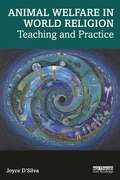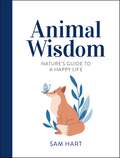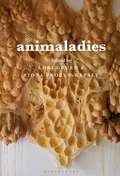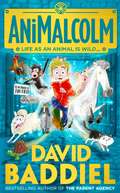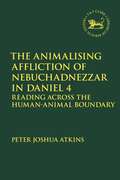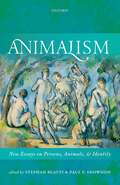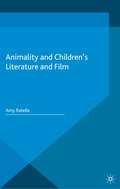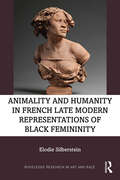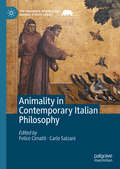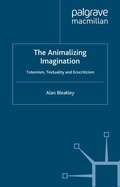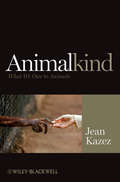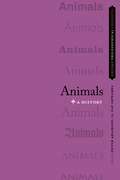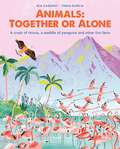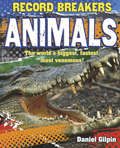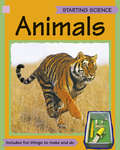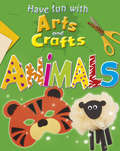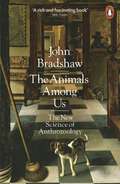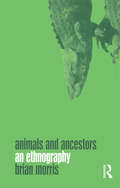- Table View
- List View
Animal Welfare in World Religion: Teaching and Practice
by Joyce D'SilvaThis unique and readable book examines the relationship between religion and animal welfare, taking a detailed dive into the teachings and practices of the major world religions. While there are many books expounding the beliefs of the major religions and many about the rights and welfare of animals, there are few linking the two. With each chapter focusing on one of the five major religions – Judaism, Christianity, Islam, Hinduism and Buddhism – the book explores the beliefs and practices which drive our relationship with and treatment of animals. The book draws on the scriptures of the major faiths and includes the voices of leading historical religious figures and contemporary faith leaders. In doing so, it compares the teachings of old with contemporary practices and showcases the impact of the major religions on both the protection and exploitation of animals, from running animal sanctuaries, to participating in or condoning cruel sports and factory farming. Importantly, the book also includes a chapter looking beyond the major world religions, where it examines a wider range of beliefs and practices, including Indigenous peoples from the USA and Australia, Jainism, Sikhism and Rastafarianism, to provide fascinating insights into another range of beliefs and views on the human-animal relationship. Overall, this book challenges and encourages religious leaders and followers to re-examine their teachings and to prioritise the well-being of animals. This book is essential reading for those interested in the role of religion in animal welfare, human-animal studies, and animal welfare and ethics more broadly.
Animal Welfare in World Religion: Teaching and Practice
by Joyce D'SilvaThis unique and readable book examines the relationship between religion and animal welfare, taking a detailed dive into the teachings and practices of the major world religions. While there are many books expounding the beliefs of the major religions and many about the rights and welfare of animals, there are few linking the two. With each chapter focusing on one of the five major religions – Judaism, Christianity, Islam, Hinduism and Buddhism – the book explores the beliefs and practices which drive our relationship with and treatment of animals. The book draws on the scriptures of the major faiths and includes the voices of leading historical religious figures and contemporary faith leaders. In doing so, it compares the teachings of old with contemporary practices and showcases the impact of the major religions on both the protection and exploitation of animals, from running animal sanctuaries, to participating in or condoning cruel sports and factory farming. Importantly, the book also includes a chapter looking beyond the major world religions, where it examines a wider range of beliefs and practices, including Indigenous peoples from the USA and Australia, Jainism, Sikhism and Rastafarianism, to provide fascinating insights into another range of beliefs and views on the human-animal relationship. Overall, this book challenges and encourages religious leaders and followers to re-examine their teachings and to prioritise the well-being of animals. This book is essential reading for those interested in the role of religion in animal welfare, human-animal studies, and animal welfare and ethics more broadly.
Animal Wisdom: Nature's Guide to a Happy Life
by Sam HartSelf-care gone wild Slow down like a sloth, stretch like a cat, breathe deep like a whale and have the confidence of a lion. When life gets you down, lift your spirits with these tiny tips and helpful hints from our friends in the animal kingdom.
Animaladies: Gender, Animals, and Madness
by Carol J. Adams Professor Lori Gruen Professor Fiona Probyn-RapseyDo depictions of crazy cat ladies obscure more sinister structural violence against animals hoarded in factory farms?Highlighting the frequent pathologization of animal lovers and animal rights activists, this book examines how the "madness†? of our relationships with animals intersects with the "madness†? of taking animals seriously. The essays collected in this volume argue that "animaladies†? are expressive of political and psychological discontent, and the characterization of animal advocacy as mad or "crazy†? distracts attention from broader social unease regarding human exploitation of animal life.While allusions to madness are both subtle and overt, they are also very often gendered, thought to be overly sentimental with an added sense that emotions are being directed at the wrong species. Animaladies are obstacles for the political uptake of interest in animal issues-as the intersections between this volume and established feminist scholarship show, the fear of being labeled unreasonable or mad still has political currency.
Animaladies: Gender, Animals, and Madness
by Lori Gruen Carol J. Adams Fiona Probyn-RapseyDo depictions of crazy cat ladies obscure more sinister structural violence against animals hoarded in factory farms?Highlighting the frequent pathologization of animal lovers and animal rights activists, this book examines how the “madness” of our relationships with animals intersects with the “madness” of taking animals seriously. The essays collected in this volume argue that “animaladies” are expressive of political and psychological discontent, and the characterization of animal advocacy as mad or “crazy” distracts attention from broader social unease regarding human exploitation of animal life.While allusions to madness are both subtle and overt, they are also very often gendered, thought to be overly sentimental with an added sense that emotions are being directed at the wrong species. Animaladies are obstacles for the political uptake of interest in animal issues-as the intersections between this volume and established feminist scholarship show, the fear of being labeled unreasonable or mad still has political currency.
AniMalcolm
by David Baddiel Jim FieldFrom David Baddiel, the brightest new star of children's books and winner of the LOLLIES award, comes a laugh-out-loud adventure for every child who ever wondered what it might be like to be a bit of an animal. . . Malcolm doesn't like animals. Which is a problem because his family love them. Their house is full of pets. What the house is NOT full of is stuff Malcolm likes. Such as the laptop he wanted for his birthday. The only bright spot on the horizon is the Year Six school trip, which Malcolm never thought his parents would pay for. And yet there he is, on the bus, heading to. . . oh no. A farm. Over the next days, Malcolm changes. He learns a lot about animals. More, in many ways, than he would like. He learns what it's really like to be an animal. A whole series of animals, in fact. . . It does make him think differently. And speak differently. And eat differently. And, um, smell differently. But will he end up the same as before? Because sometimes the hardest thing to become is. . . yourself.
AniMalcolm (PDF)
by David Baddiel Jim FieldFrom David Baddiel, the brightest new star of children's books and winner of the LOLLIES award, comes a laugh-out-loud adventure for every child who ever wondered what it might be like to be a bit of an animal. . . Malcolm doesn't like animals. Which is a problem because his family love them. Their house is full of pets. What the house is NOT full of is stuff Malcolm likes. Such as the laptop he wanted for his birthday. The only bright spot on the horizon is the Year Six school trip, which Malcolm never thought his parents would pay for. And yet there he is, on the bus, heading to. . . oh no. A farm. Over the next days, Malcolm changes. He learns a lot about animals. More, in many ways, than he would like. He learns what it's really like to be an animal. A whole series of animals, in fact. . . It does make him think differently. And speak differently. And eat differently. And, um, smell differently. But will he end up the same as before? Because sometimes the hardest thing to become is. . . yourself.
Animalising Affliction of Nebuchadnezzar in Daniel 4: Reading Across the Human-Animal Boundary (The Library of Hebrew Bible/Old Testament Studies)
by Peter Joshua AtkinsThis is a detailed investigation into the nature of Nebuchadnezzar's animalising affliction in Daniel 4 and the degree to which he is depicted as actually becoming an animal. PeterAtkins examines two predominant lines of interpretation: either Nebuchadnezzar undergoes a physical metamorphosis of some kind into an animal form; or diverse other readings that specifically preclude or deny an animal transformation of the king. By providing an extensive study of these interpretative opinions, alongside innovative assessments of ancient Mesopotamian divine-human-animal boundaries, Atkins ultimately demonstrates how neither of these traditional interpretations best reflect the narrative events. While there have been numerous metamorphic interpretations of Daniel 4, these are largely reliant upon later developments within the textual tradition and are not present in the earliest edition of Nebuchadnezzar's animalising affliction. Atkins' study displays that when Daniel 4 is read in the context of Mesopotamian texts, which appear to conceive of the human-animal boundary as being indicated primarily in relation to possession or lack of the divine characteristic of wisdom, the affliction represents a far more significant categorical change from human to animal than has hitherto been identified.
Animalism: New Essays on Persons, Animals, and Identity
What are we? What is the nature of the human person? Animalism has a straightforward answer to these long-standing philosophical questions: we are animals. After being ignored for a long time in philosophical discussions of our nature, this idea has recently gained considerable support in metaphysics and philosophy of mind. It has also, amongst philosophers, occasioned strong opposition, even though it might be said to be the view assumed by much of the scientific community. Essays on Animalism is the first volume to be devoted to this important topic and promises to set the agenda for the next stage in the debate. Containing mainly new papers as well as two highly important articles that were recently published elsewhere, this volume's contributors include both emerging voices in the debate and many of those who have been instrumental in shaping it. Some of their contributions defend animalism, others criticize it, still others explore its more general implications. The book also contains a substantial introduction by the editors explaining what animalism is, identifying leading issues that merit attention, and highlighting many of the issues that the contributors have raised.
Animality and Children's Literature and Film (Critical Approaches to Children's Literature)
by A. RatelleExamining culturally significant works of children's culture through a posthumanist, or animality studies lens, Animality and Children's Literature and Film argues that Western philosophy's objective to establish a notion of an exclusively human subjectivity is continually countered in the very texts that ostensibly work to this end.
Animality and Humanity in French Late Modern Representations of Black Femininity (Routledge Research in Art and Race)
by Elodie SilbersteinThis volume examines the evolution of the depictions of black femininity in French visual culture as a prism through which to understand the Global North’s destructive relationship with the natural world. Drawing on a broad spectrum of archives extending back to the late 18th century – paintings, fashion plates, prints, photographs, and films – this study traces the intricate ways a patriarchal imperialism and a global capitalism have paired black women with the realm of nature to justify the exploitation both of people and of ecosystems. These dehumanizing and speciesist strategies of subjugation have perpetuated interlocking patterns of social injustice and environmental depletion that constitute the most salient challenges facing humankind today. Through a novel approach that merges visual studies, critical race theory, and animal studies, this interdisciplinary investigation historicizes the evolution of the boundaries between human and non-human animals during the modern period. The book will be of interest to scholars working in art history, visual studies, critical race theory, colonial and post-colonial studies, animal studies, and French studies.
Animality and Humanity in French Late Modern Representations of Black Femininity (Routledge Research in Art and Race)
by Elodie SilbersteinThis volume examines the evolution of the depictions of black femininity in French visual culture as a prism through which to understand the Global North’s destructive relationship with the natural world. Drawing on a broad spectrum of archives extending back to the late 18th century – paintings, fashion plates, prints, photographs, and films – this study traces the intricate ways a patriarchal imperialism and a global capitalism have paired black women with the realm of nature to justify the exploitation both of people and of ecosystems. These dehumanizing and speciesist strategies of subjugation have perpetuated interlocking patterns of social injustice and environmental depletion that constitute the most salient challenges facing humankind today. Through a novel approach that merges visual studies, critical race theory, and animal studies, this interdisciplinary investigation historicizes the evolution of the boundaries between human and non-human animals during the modern period. The book will be of interest to scholars working in art history, visual studies, critical race theory, colonial and post-colonial studies, animal studies, and French studies.
Animality in Contemporary Italian Philosophy (The Palgrave Macmillan Animal Ethics Series)
by Carlo Salzani Felice CimattiThis volume provides an overview of contemporary Italian philosophy from the perspective of animality. Its rationale rests on two main premises: the great topicality of both Italian contemporary philosophy (the so-called “Italian Theory”) and of the animal question (the so-called “animal turn” in the humanities and the social sciences) in the contemporary philosophical panorama. The volume not only intersects these two axes, illuminating Italian Theory through the animal question, but also proposes an original thesis: that the animal question is a central and founding issue of contemporary Italian philosophy. It combines historical-descriptive chapters with analyses of the theme in several philosophical branches, such as biopolitics, Posthumanism, Marxism, Feminism, Antispeciesism and Theology, and with original contributions by renowned authors of contemporary Italian (animal) philosophy. The volume is both historical-descriptive and speculative and is intended for a broad academic audience, embracing both Italian studies and Animal studies at all levels.
The Animalizing Imagination: Totemism, Textuality and Ecocriticism
by A. BleakleyAnimals appear not just as biological creatures, but as vehicles of meaning for human imagination, mind and culture. Animal life may form the basis for an animalizing imagination that can enhance our cultural, religious and aesthetic sensibilities. This imagination is rooted in the pre-modern affective relationship between shamans and their familiars, but can be tracked to our post-modern ecological crisis, where we can reclaim a totemic identification with animals as signifiers of a new ecological understanding.
Animalkind: What We Owe to Animals (Blackwell Public Philosophy Series)
by Jean KazezBy exploring the ethical differences between humans and animals, Animalkind establishes a middle ground between egalitarianism and outright dismissal of animal rights. A thought-provoking foray into our complex and contradictory relationship with animals Advocates that we owe each animal due respect Offers readers a sensible alternative to extremism by speaking of respect and compassion for animals, not rights Balances philosophical analysis with intriguing facts and engaging tales
Animals: A History (Oxford Philosophical Concepts)
by Peter Adamson G. Fay EdwardsPhilosophical controversy over non-human animals extends further back than many realize -- before Utilitarianism and Darwinism to the very genesis of philosophy. This volume examines the richness and complexity of that long history. Twelve essays trace the significance of animals from Greek and Indian antiquity through the Islamic and Latin medieval traditions, to Renaissance and early modern thought, ending with contemporary notions about animals. Two main questions emerge throughout the volume: what capacities can be ascribed to animals, and how should we treat them? Notoriously ungenerous attitudes towards animals' mental lives and ethics status, found for instance in Aristotle and Descartes, are shown to have been more nuanced than often supposed, while remarkable defenses of benevolence towards animals are unearthed in late antiquity, India, the Islamic world, and Kant. Other chapters examine cannibalism and vegetarianism in Renaissance thought, and the scientific testing of animals. A series of interdisciplinary reflections sheds further light on human attitudes towards animals, looking at their depiction in visual artworks from China, Africa, and Europe, as well as the rich tradition of animal fables beginning with Aesop.
Animals: A crash of rhinos, a waddle of penguins and other fun facts
by Mia CassanySome animals need to live in big groups, although others barely interact with the rest of the herd. Do you want to know why?This book is full of colourful illustrations answering the questions of how, why and when animals decide to live in groups or alone. This useful and entertaining resource helps you discover fun facts about Flamingos, Polar Bears, Zebras, Emperor penguins and many more!
Animals: Animals Library Ebook (Record Busters #1)
by Daniel GilpinPerfect for capturing a young general reader's or an older reluctant reader's interest, these hi-lo titles feature gripping, minimal, fact-based text, dramatic and impactful pictures, and an edgy design to reveal the fastest, tallest, smallest, oldest or quirkiest!
Animals: Animal Homes (Project Science)
by Sally HewittFun, lively introductions to science with practical activities and projects to strengthen learning.
Animals (Have Fun with Arts and Crafts #5)
by Rita StoreyFun and engaging arts and crafts ideas centring on children's interests.
Animals: A History (Oxford Philosophical Concepts)
Philosophical controversy over non-human animals extends further back than many realize -- before Utilitarianism and Darwinism to the very genesis of philosophy. This volume examines the richness and complexity of that long history. Twelve essays trace the significance of animals from Greek and Indian antiquity through the Islamic and Latin medieval traditions, to Renaissance and early modern thought, ending with contemporary notions about animals. Two main questions emerge throughout the volume: what capacities can be ascribed to animals, and how should we treat them? Notoriously ungenerous attitudes towards animals' mental lives and ethics status, found for instance in Aristotle and Descartes, are shown to have been more nuanced than often supposed, while remarkable defenses of benevolence towards animals are unearthed in late antiquity, India, the Islamic world, and Kant. Other chapters examine cannibalism and vegetarianism in Renaissance thought, and the scientific testing of animals. A series of interdisciplinary reflections sheds further light on human attitudes towards animals, looking at their depiction in visual artworks from China, Africa, and Europe, as well as the rich tradition of animal fables beginning with Aesop.
The Animals Among Us: The New Science of Anthrozoology
by John Bradshaw'A pioneering study ... richly, empathetically and affectionately respectful of the human-animal bond' Sunday TimesWhy do humans love animals? The bestselling author of In Defence of Dogs and Cat Sense gives us the answers.Keeping pets is expensive, time-consuming, and seemingly irrational - so why do so many of us have an animal in our lives?Modern-day pet-keeping has been justified for many reasons, from the potential therapeutic role pets can play, to their appealing 'cuteness'. But pet-keeping is much more than just a simple pastime. It is part of the broader history of humanity's relationship with animals - a relationship that comes from deep within our nature. As John Bradshaw reveals in this highly original new work, our connection with animals is one of the very things that makes us human. In The Animals Among Us, Bradshaw takes us to the heart of Anthrozoology, a new science dedicated to discovering the true nature and depth of the human-animal bond. Following the thread of our affection for animals, from today's pet lovers all the way back to our ancient ancestors, Bradshaw reveals how animals have always been an integral part of our lives: indeed, they have shaped the evolution of our minds and our bodies. The ways in which we relate to animals today stem ultimately from our evolutionary journey from hominid to Homo sapiens.An affinity for animals drove our evolution as humans. Now, as increasing numbers of species are under threat, John Bradshaw shows us that pet-keeping can act as a bridge between the domestic and the wild, even aiding conservation. If we lose the animals among us, he warns, we risk losing an essential part of ourselves.
Animals and African Ethics (The Palgrave Macmillan Animal Ethics Series)
by Kai HorsthemkeThe claim is frequently made on behalf of African moral beliefs and practices that they do not objectify and exploit nature and natural existents like Western ethics does. This book investigates whether this is correct and what kind of status is reserved for other-than-human animals in African ethics.
Animals and Alternatives in Toxicology: Present Status and Future Prospects
This volume considers the second report of the FRAME Toxicity Committee presenting reviews and discussions by invited authors and general discussions. It covers developments in toxicology and the use of non-animal methods in toxicity testing since the first report, published in 1983; it highlights the need for rationalisation and harmonisation of regulatory guidelines for more critical attitudes toward currently accepted animal tests and for more attention to be focussed on non-animal alternatives; how to inform scientists of alternatives to animals; and how to develop and integrate non-animal alternatives. The book is a key document in the development, validation, and use of non-animal methods and is aimed at toxicologists, pharmacologists, and policy-makers in academia, industry and government.
Animals and Ancestors: An Ethnography
by Brian MorrisEver since the emergence of human culture, people and animals have co-existed in close proximity. Humans have always recognized both their kinship with animals and their fundamental differences, as animals have always been a threat to humans' well-being. The relationship, therefore, has been complex, intimate, reciprocal, personal, and -- crucially -- ambivalent. It is hardly surprising that animals evoke strong emotions in humans, both positive and negative. This companion volume to Morris' important earlier work, The Power of Animals, is a sustained investigation of the Malawi people's sacramental attitude to animals, particularly the role that animals play in life-cycle rituals, their relationship to the divinity and to spirits of the dead. How people relate to and use animals speaks volumes about their culture and beliefs. This book overturns the ingrained prejudice within much ethnographic work, which has often dismissed the pivotal role animals play in culture, and shows that personhood, religion, and a wide range of rituals are informed by, and even dependent upon, human-animal relations.
